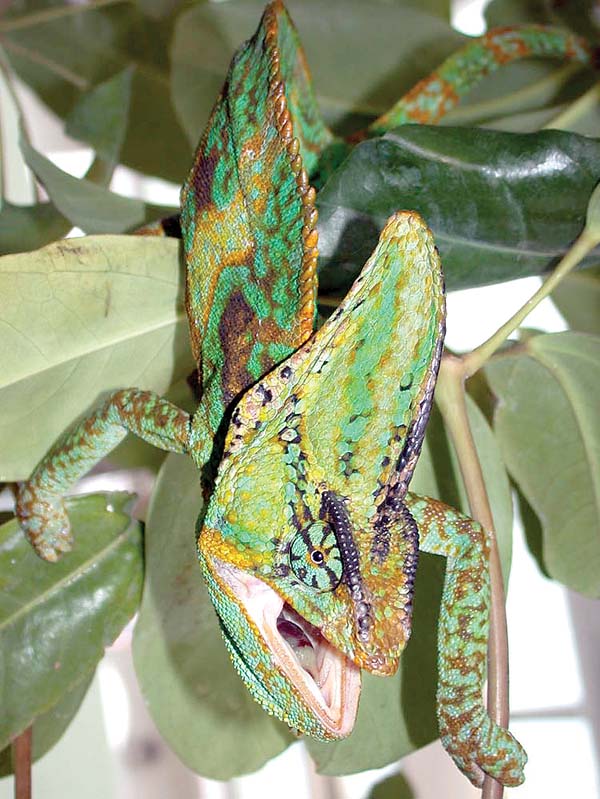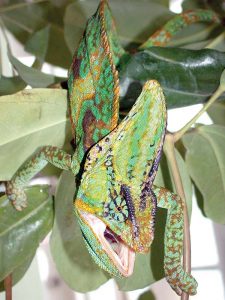With invasive species, flattening curve requires cooperation
KIA'I MOKU

The veiled chameleon, recognizable by its shark-fin-shaped head, is thought to be eradicated from Maui, thanks to widespread community cooperation and a commitment to seeing the effort to the end. — Maui Invasive Species Committee
In 2002, an unusually large and strange looking chameleon turned up in a remote area of West Maui. The resulting media attention led to the detection of a population of the same species in Makawao. These lizards weren’t the familiar Jackson’s chameleons, but a new and different species: veiled chameleons. Native to Yemen and Saudi Arabia, these invaders posed a threat to our endemic forest birds and snails. Staff from the Maui Invasive Species Committee (MISC), state Department of Agriculture and Department of Land and Natural Resources launched nighttime surveys, scouring the vegetation in the backyards of Makawao looking for these cryptic reptiles.
During initial searches, the teams found chameleons easily: they were distinctive, larger than their horned cousins and sporting a “shark fin” head, and clung to tree branches as they slept. The community helped by allowing searchers into their backyards and by finding and turning in chameleons on their own.
In 2003, search crews and residents captured a total of 102 lizards, but over time, the numbers steadily declined. From multiple chameleons per night, searchers started to find only one or two per week. Then came months when crews came back from a week of searching without finding a single chameleon. Searchers counted Jackson’s chameleons to stay focused on their task. As numbers continued to drop, the time between searches increased. The last capture was in 2008. In 2012, after a final search and outreach to the community, the agencies agreed: veiled chameleons had been eradicated from all known locations on Maui. Addressing the threat early, with community cooperation, prevented the spread of this species into new locations, including higher-elevation rainforests, the last habitat for our native birds and snails.
The language and processes used to stop an invasive species before it becomes widespread mirror the terms used to address an outbreak of a contagious and serous disease. As the COVID-19 pandemic spread worldwide and social distancing measure were implemented, Jane Mangold, invasive plant specialist at Montana State University, considered the similarities in a monthly blog post that circulated through the invasive species community: “One of the most obvious parallels is the importance of prevention, early detection and rapid response. ‘Flattening the curve’ has been stated repeatedly by experts keeping us informed about the pandemic; the rationale behind this phrase is that by slowing the spread of the disease, medical providers will have more time and resources to treat those in need, and ultimately save more lives,” Mangold said.
Initially, reducing the spread of the chameleons cost a lot: hunters had to spend many hours searching to effectively interrupt the reproductive cycle. So too for COVID-19, after months of social distancing and huge economic impacts, the number of new cases has dropped and the curve has flattened. There are other parallels between controlling the spread of human disease and pests.
Those last few chameleons were likely the most time consuming and expensive to remove, but if they hadn’t been captured, the population could have rebounded. Working past the frustration and searcher fatigue to find the few remaining individuals was critical to achieving eradication. While eliminating a small population of lizards is not readily comparable to addressing and suppressing a global health pandemic, similar elements lead to success: widespread cooperation by those affected and diligence and commitment to seeing the effort through the long tail of the curve to a resolution. And of course, for both the chameleon and COVID-19, local reintroduction remains a possibility.
We can all do our part to maintain vigilance. And if you happen to see a strange chameleon with a shark-fin on its head while you are at home, report it to MISC at 573-6472. Veiled chameleons and other illegally owned reptiles can be turned in through the state Department of Agriculture’s amnesty program.
Learn more about the veiled chameleon at dlnr.hawaii.gov/ hisc/info/invasive-species-profiles/veiled-chameleon/.
* Lissa Strohecker is the public relations and education specialist for the Maui Invasive Species Committee. She holds a biological sciences degree from Montana State University. “Kia’i Moku,” “Guarding the Island,” is prepared by the Maui Invasive Species Committee to provide information on protecting the island from invasive plants and animals that can threaten the island’s environment, economy and quality of life.
- The veiled chameleon, recognizable by its shark-fin-shaped head, is thought to be eradicated from Maui, thanks to widespread community cooperation and a commitment to seeing the effort to the end. — Maui Invasive Species Committee



